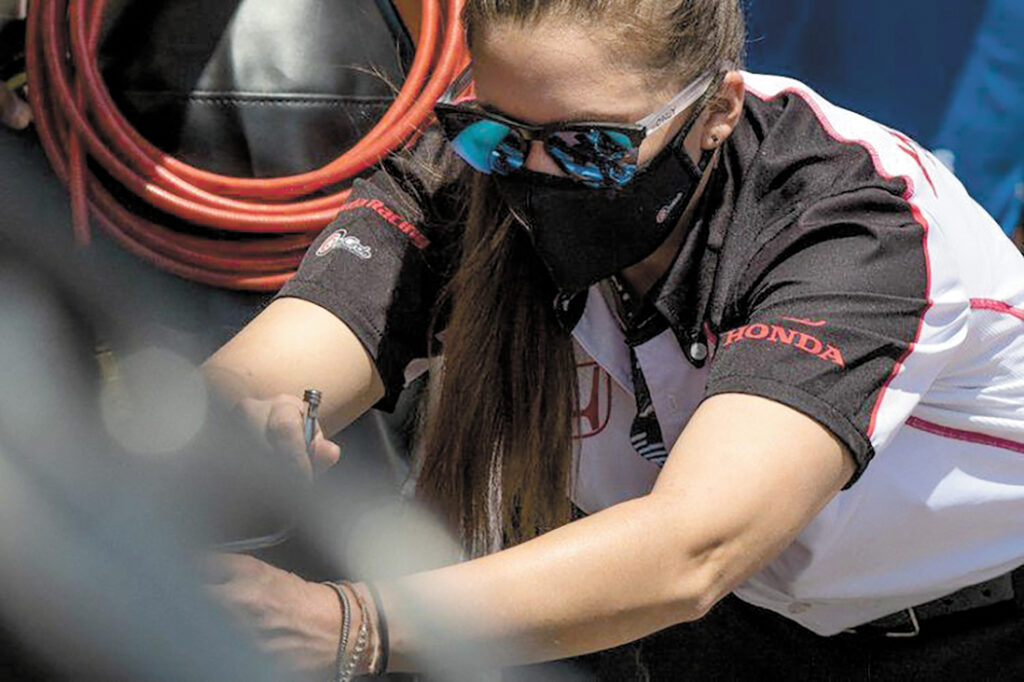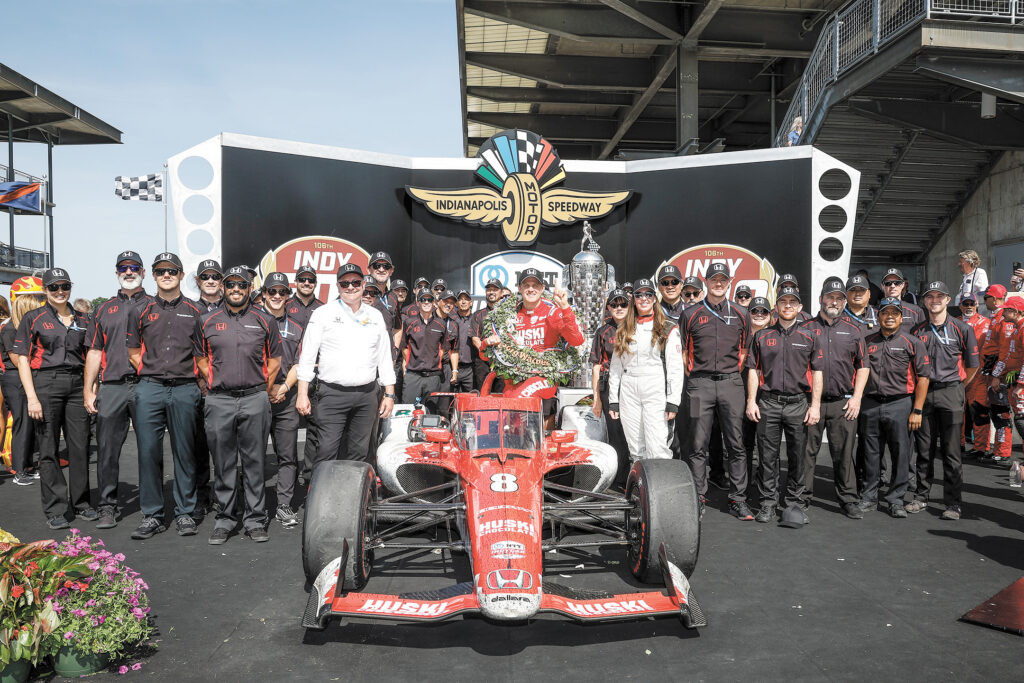
By Elizabeth Wulfhorst
INDIANAPOLIS – When Nicole Rotondo got the green flag to work her dream job at Honda, she never really thought about being a trailblazer. But that’s exactly what happened Sunday at the 106th running of the Indianapolis 500 – Marcus Ericsson crossed the finish line under the checkered flag and Rotondo became Honda’s first woman trackside support engineer on a winning team.
Rotondo grew up in Middletown helping her dad fix almost every engine imaginable, “everything from cars, boats, jet skis, lawnmowers he picked up off the side of the road,” she said. After graduating from Marine Academy of Science and Technology on Sandy Hook, Rotondo attended Rochester Institute of Technology and received her degree in mechanical engineering with an automotive focus.
She worked first as a body design engineer but knew motorsports was her passion. This is Rotondo’s fourth season as a trackside engineer.
She trained on Graham Rahal’s car for a year and then Honda assigned her to Chip Ganassi Racing’s No. 8 in 2020. Every team that leases a Honda engine gets assigned an engineer to work on the timing stand with that team for race season. Honda is one of the two engine providers for the IndyCar Series. Rotondo attends all the IndyCar events No. 8 competes in. A typical race sees her flying to the event site and working closely with the rest of the Honda team.
“I get the car fired up in the morning, and then I will be on the timing stand with them all weekend,” Rotondo explained. “I’ll be one of the nerds with the headsets and the laptop talking to Marcus and telling him the things that he needs to know about the engines and also watching the engine and making sure that the vitals look OK and making sure that it’s performing how it’s supposed to.”
Throughout the weekend she’ll make adjustments to the engine, but gone are her days of working with wrenches, pliers and screwdrivers. Once the sealed engines leave Honda Performance Development in California, “there’s very little that we’re mechanically allowed to adjust on the engine,” Rotondo said. Instead she makes changes “electronically through our laptops.”
Rotondo will analyze the data gathered during practice runs leading up to the race and plug any changes into the car, then send it out for more practice. “We’ll do that through all the practices up until qualifying and then in between qualifying and the race we’ll probably make a couple more changes,” she said.

She can’t “communicate” with the engine while the car is on the track, but she can “monitor its vitals” and talk to the driver.
If a big problem arises during a race, the driver can pull in and let Rotondo plug into the car to make changes, but that is a scenario they try very hard to avoid as it means losing a lot of time. “For the most part, everything we do during the race is through this series of switches and buttons (in the car) that Marcus has preprogrammed so he can use the different combinations of those to try and address an issue – if there’s an engine issue on track or just to save fuel or get more power, whatever he needs depending on what he’s trying to achieve that lap,” she said.
Rotondo said race day is “a lot to process. It’s very, very exciting. It’s very, very stressful.” She noted the Indy 500 is quite different from the other races in the series. “It has a lot of pomp and circumstance surrounding it.”

She and the team got to the track before 5 a.m. race day, giving them a full eight hours to get the cars ready. Meanwhile, there were parades, flyovers, anthems and more happening around the track. “That time is a little bit stressful because, as a rule of thumb, we try not to make any changes that we haven’t run on track. You don’t really want to run anything that’s not proven,” she said. “So you’ve got all morning to sit there and think about things. Everybody’s revved up, there’s so much energy and everybody’s just ready to go all morning. We just want to do the thing.”
Rotondo said, for her, the start of the race is when she is most anxious. “I’m actually out on the grid with the car before they take off,” she said. “I’m plugged into the car when they do ‘Drivers, start your engines’ and I make sure everything looks OK. And then I run over to the pit wall and stand there and hope that the car takes off,” she explained with a laugh.
And take off it did. Ericsson began the race in fifth position and ran a majority of it in third behind two other Chip Ganassi Racing cars. By the final 10 laps, Ericsson’s Huski Chocolate car was running in first with a 3-second lead on the car behind him, “which in our world is a big gap,” Rotondo said.
“We were a clear shot to win the race. We weren’t worried about running out of fuel or anything like that,” she said.
And then came the red flag.
On Lap 194, Jimmie Johnson, a NASCAR legend but IndyCar rookie, spun into a barrier and all cars went to the pits for nearly eight minutes until the track was cleared. After a red flag, the cars have to line up to restart the race. While Ericsson remained in the front, “that 3-second gap that we had to the second car was gone,” Rotondo said. “Now that second place car was on his bumper.”
“I think I stopped breathing for the entire last 20 minutes of the race!” she joked. “My team leader actually brought me my inhaler in the winner’s circle because he was so nervous about how stressful it was.”

Now that she’s had some time to process the win – and kiss the bricks and drink the milk – Rotondo said she’s thankful for the support of her family and friends and teammates. “Ever since I started with this IndyCar thing, the whole family watches,” she said. “Most of them were not race fans or car fans or anything at all. And now they’re probably some of the biggest race fans in IndyCar.”
She said she hasn’t fully appreciated the historic implications of being the first woman engineer at Honda to be on the winning team. “They are quite a few other women engineers at Honda,” she explained, but only she and one other currently work trackside. There is another woman employed by the Chip Ganassi Racing team as an assistant engineer who works on Marcus Ericsson’s car.
Rotondo said she hasn’t noticed any women trackside for Chevy (the other company that supplies engines for the IndyCar Series) so after Ericsson won, “It was kind of a moment of, like, ‘Hmm, I may be the first girl to do this with an engine. That’s kind of neat.”
She recommends any young woman interested in engineering just “do it.”
“In the time that I’ve been in IndyCar, the number of women has probably doubled, on timing stands, mechanics, in the pits,” she said, noting she was raised to do anything she wanted to.
“My dad let me do anything he let my brother do. So I never really thought twice about it.”
Rotondo said she thinks motorsports is the “perfect environment” for women because, “when you’re at the racetrack, nobody pays attention to who you are or what you look like. There’s too much going on for that.”
“If you can get there and you can get your stuff done, that’s all that matters,” she said.
Rotondo noted she never would have accomplished what she did “without that whole group (at Honda) and without Ganassi being that incredible team.”
Winning the Indy 500 was “definitely a team effort, for sure,” she said.
“There’s a huge office of Honda people that get me to that point. They build the engine and they do a lot of the base work on the engine which is what allows me to go after that extra tenths of a mile an hour” that makes the difference in this fast-spaced sport.
“You can never really say, ‘I did this thing.’ We did this thing.”
This article originally appeared in the June 2 – 8, 2022 print edition of The Two River Times.














